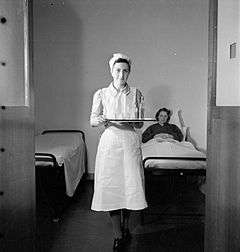Nurse uniform

A nurse uniform is attire worn by nurses for hygiene and identification. The traditional nurse uniform consists of a dress, apron and cap. It has existed in many variants, but the basic style has remained recognizable.
History

The first nurse uniforms were derived from the nun's habit. Before the 19th century, nuns took care of sick and injured people so it was obvious that trained lay nurses might copy the nun's habit as they have adopted ranks like "Sister". One of Florence Nightingale's first students (Miss van Rensselaer) designed the original uniform for the students at Miss Nightingale's school of nursing. Before the 1940s minor changes occurred in the uniform. The clothing consisted of a mainly blue outfit. Hospitals were free to determine the style of the nurse uniform, including the nurse's cap which exists in many variants.[1]

In Britain, the national uniform (or simply "national") was designed with the advent of the National Health Service (NHS) in 1948, and the Newcastle dress. From the 1960s open necks began to appear. In the 1970s, white disposable paper caps replaced cotton ones; in the 1980s, plastic aprons displaced the traditional ones and outerwear began to disappear. From the 1990s, scrubs became popular in Britain, having first appeared in the USA; however, some nurses in Britain continue to wear dresses, although some NHS trusts have removed them in favour of scrubs as in many other countries.
Standard nurse's uniform
Historically, a typical nurse uniform consisted of a dress, pinafore apron and nurse's cap. In some hospitals, however, student nurses also wore a nursing pin, or the pinafore apron may have been replaced by a cobbler style apron. This type of nurse's dress continues to be worn in many countries.
Alternative nurse uniforms
_of_New_York%2C_a_Registered_Nurse_and_Clinical_administrator_for_the_Los_Angeles_County%2C_University_of_Southern_California.jpg)
Since the late 1980s, there has been a move towards alternative designs of nursing uniforms in some countries. Newer style nurse's uniform in the United Kingdom consists of either: [2][3][4]
- A tunic-style top and dark blue trousers that are optimally designed to prevent cross-infection, the colour of which depends upon the grade (or, more recently, band) and gender of the nurse — the colour varies between NHS Trusts. The tunics often feature piping around the edges of the uniform.
- A dress in the same colour as the tunic-style top.[5]
Male nursing uniform
Male nurses generally wear a different uniform to their female counterparts. Male Nurses wear a white tunic with epaulettes in a colour or quantity that represents their year of training or grade. Traditional uniforms remain common in many countries, but in Western Europe and North America, the so-called "scrubs" or tunics have become more popular. "Scrub dress" is a simpler type of uniform, and is almost always worn in operating rooms and emergency rooms.
Nurse uniforms vs scrubs

Beginning in the 1990s, and until the present time, the traditional nurse uniforms have been replaced with the "new" scrub dress in some countries. Most hospitals in the USA and Europe argue that the scrub uniform is easier to clean than the old nurse uniforms. The nurses who wear the uniforms are divided into two camps:
- Those who prefer the new scrubs; disliked the old white nurse dress uniforms.
- The nurses who liked the old white nurse dress uniforms; they argue that nurses who wear scrubs are seen by the patients as cleaners or surgeons and cannot be identified as nurses.
In many parts of the world, nurses continue to wear a white uniform consisting of a dress and cap. The traditional white uniform for male nursing staff is now going out of fashion, excepting for student nurses. A tunic of either the dental surgeon style or a V-neck with a collar is very often used. The colours vary with grade, area of work, and hospital; however, the male equivalent of a sister (that is, charge nurse) tend to be shades of blue or dark green: often, this is the only colour to be recognised by the public as signifying a person in authority.
Nursing jewellery

Nurses were actively discouraged from wearing jewellery which might distract from their purpose and get caught on patient skin during care activity. A fob watch or pendant watch is considered synonymous with nursing. The fob watch frees the nurses' hands for client care and prevents the wrist watch becoming a vector for disease. Watches are sometimes given as a token rite-of-passage gift from parents to young nurses, who are making the transition into nurses' quarters and live away from home for the first time.
See also
References
- ↑ "History of Cheddleton (St. Edwards) Mental Hospital since 1900". Retrieved 6 December 2009.
- ↑ "dyk2".
- ↑ "Paul Diamond - L.L.M (University of Cambridge)".
- ↑ Trust, Copyright (c) 2016 Oxford University Hospitals NHS. "Oxford University Hospitals".
- ↑ Eve, Irene (4 July 2010). "Polytex Technologies implements multiple automated medical textile management systems in hospitals and healthcare institutions". Polytex Technologies LTD. Retrieved 26 October 2016.
